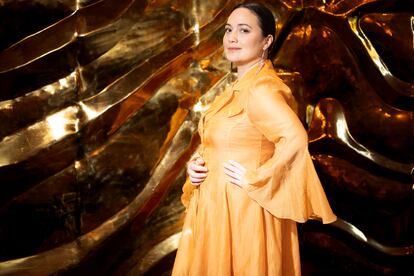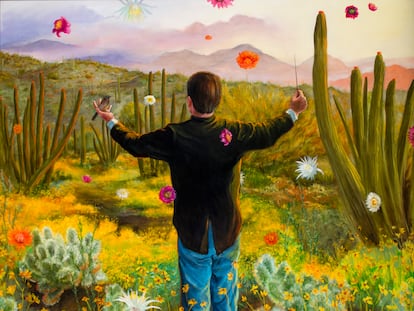Lily Gladstone, Oscar nominee for ‘Killers of the Flower Moon’: ‘The world has to start getting worried about the return of Trump’
The Piegan Blackfeet and Nez Perce actress feels the weight of ‘being an ambassador for a great community,’ and fights to communicate to fans that the film’s true protagonists are the Osage


When Lily Gladstone (Kalispell, Montana, 37 years old) was a little girl, her father made her believe he had powers. “He used to play jokes on me. For example, that he had control over the clouds because he was a magician. He played tricks that I didn’t catch at the time. He still has that playful spirit. Nowadays, he takes care of my dog when I travel. And since we share location by cell phone, when I’m 400 meters from our house, he’ll open the window and shout my name, as if he were summoning me. Of course, my dog is convinced that I show up at the door because he called me,” laughs the actress. “But he is also the father who gave me the courage to go out into life, and a deep respect for my roots [which come from the Blackfeet and Nez Perce peoples]. He gave me the name of his grandmother, Lily. I even got to know her younger brother, my great-grand uncle. My father insisted that I not lose connection with either family, or my community. When I was bullied in school, he always reminded me that I was better, and said, ‘They’ll want to be your friend when you win the Oscar.’ Which is to say, he’s got some kind of power. Who knows?” she says, with a hint of irony.
Gladstone, the protagonist of Martin Scorsese’s Killers of the Flower Moon, came to Madrid on Friday for a press junket sponsored by the Academy. While the director spoke at an event hosted by Madrid’s School of Cinematography and Audiovisual, the actress, who is nominated for Best Actress, sat down with EL PAÍS for an interview and photoshoot. In contrast with her character Mollie Burkhart, Gladstone talks — a lot. What she and Mollie have in common is a certain calm demeanor, a sense of being in control of the situation, albeit that this is a quality that does not help Burkhart, an Osage woman, to pump the brakes on the misfortune that surrounds her. They call it the reign of terror, an era (which took place in the 1920s) in which whites — who had already forced the Osage to leave their home, in what is known as Kansas, for the Oklahoma wastelands — spirited away the tribe’s wealth, which they had earned in the wake of the unexpected appearance of oil reserves on their adopted lands. How did they carry off this theft? Through murder and the evils of inheritance.
That genocide was the basis for the book Killers of the Flower Moon by David Grann, and eventually, the Scorcese film by the same name, which was presented at the last Cannes Film Festival and can now be seen on Apple TV+ after a successful run in movie theaters. “I knew of this story as a teenager, because I did ballet and admired Marie Tallchief [the first great U.S. ballerina, who was an Osage and married legendary choreographer George Balanchine], before I moved on to acting,” Gladstone remembers. “But at the time, neither I nor anyone around me know how brutal the story was. It sounded like people were stealing from Natives to get rich. It was only after the publication of Grann’s book that we understood the seriousness and its strange relationship to the beginning of the FBI. When I read it, I understood that this was another example of racism and systematic corruption.”
The actress breathes deeply and continues her story: “That message that the Osage needed guardianship over their lives, the whole protection program that declared them incapable, for their own good, of managing their earnings, has been painfully steeped into every Native American. Starting in the mid-1990s, and continuing for a decade, there was a Blackfeet lawyer, Elouise P. Cobell, who took the U.S. government to court for malpractice over the guardianship program, whose very existence was brutal. There had been absolutely no compensation.” In 2010, both sides reached an agreement that did not involve the restoration of what was stolen — only a part of it — but which has served in the negotiation of subsequent agreements. “Even today, there are churches, congregations, banks and oil companies that own the rights of the Osage. Their struggle to get back what is theirs, what is right, continues.”

Landing directly in the path of this ongoing struggle is the possibility that, in November 2024, Donald Trump will once again become president of the United States. “It doesn’t just frighten my community, the world has to start worrying about this. The injustice of U.S. policies, not only those that come from Trump, has a global impact. Now, we as Native Americans have survived every wave of colonization. And we’re still here. Many things survived his first presidency. Our communities continued to take care of themselves, we found support in each other. I am more concerned about the worldwide rise of authoritarianism. Never in history has there been a time like the present, with such a large collective movement in pursuit of censorship and prohibition. I, at least, have confidence in the new generations.”
Community spokesperson
Killers of the Flower Moon has made this actress, who was on the brink of looking for another job, the global spokesperson of an entire community. “I do indeed feel the weight. There have been a lot of performers who, have suddenly become famous, and they don’t have to worry about anything but their art. I am the first Native American and the third Indigenous person to be nominated for an acting Oscar [preceded by Keisha Castle-Hughes for Whale Rider in 2004 and Yalitza Aparicio for Roma in 2018]. I have become a kind of ambassador for a community of very diverse people, who, yes, have a certain common past, but in the end, we have lived through very different situations, given each tribe’s relationship with the U.S. government. It’s an enormous burden for one person,” she says.
For a few moments, Gladstone holds her gaze steady, then focuses on a pen, as if it were another tool to help her articulate her thoughts. Then, she continues: “My friend Sterlin Harjo decided to end his series Reservation Dogs [on which Gladstone has worked] because of these issues. As representatives of a community, our art carries a social burden. Sterlin, despite his success, chose to end it when he wanted to end it, to not be canceled. We owe it to those children, to ourselves, who grew up watching Westerns in which the Indians were the villains. Do you understand how we felt? How we thought the rest of society saw us? That’s why it’s so important to see Indian women on screen in real, honest stories.”

Gladstone dreams that young girls around the world will see her work and know that they can achieve their dreams, too. “I was in high school, I think, when Whale Rider came out. And I felt like it spoke to me, it inspired me. Then I was hurt by the cynicism that surrounded Aparicio throughout her awards season, about how she wasn’t acting, when she had constructed such a superb performance… I want to see her again, as any character.”
After studying acting, Gladstone turned to teaching, and became interested in the Brazilian movement of the Theatre of the Oppressed. Little by little, she began finding roles, particularly with director Kelly Reichardt, in Certain Women and First Cow. “That cinema, and its size, is what I adore. With Kelly, I got to know the festival circuit, and filming for the love of this art. Thanks to those roles I met Marty [Scorsese]”, she says. She was signing up for a data analysis course, in the middle of the pandemic in 2020, in Montana, at her parent’s house, where she had moved to help them take care of her grandmother, when she received an email announcing Zoom auditions for Killers of the Flower Moon. “I never imagined what a blast it would be working with Marty,” she says. Gladstone remembers the back-and-forth over wanting to be an actress that she was experiencing when that email arrived: her need for a stable income, caring for her father, who had a heart condition… After several video call interview, which included a try-out with Leonardo DiCaprio, she was offered the role on December 1, 2020, Mollie Burkhart’s birthday. “For me, it was a sign. Her spirit chose me… I mean, she was Catholic, I don’t think her spirit is just wandering around.”

Now, she’s facing the final days of the wait for the Oscars, where her primary rival is Emma Stone, who is nominated for Poor Things. At first, it was rumored that Gladstone would be nominated in the Best Supporting Actress category. “Those were early speculations, because it was not a supporting role, because the role of the most important Osage in the film should not be considered a filler character,” she says. “It would have meant going backwards, to the spirit of that reign of terror, it would have been a disservice to Mollie and to the Osage who worked so hard on this film.” Would she have been a safer bet, nominated in the supporting actress category? “Maybe, but it’s not about me. It’s about them. Competing as lead actress means respecting Mollie.”
Sign up for our weekly newsletter to get more English-language news coverage from EL PAÍS USA Edition
Tu suscripción se está usando en otro dispositivo
¿Quieres añadir otro usuario a tu suscripción?
Si continúas leyendo en este dispositivo, no se podrá leer en el otro.
FlechaTu suscripción se está usando en otro dispositivo y solo puedes acceder a EL PAÍS desde un dispositivo a la vez.
Si quieres compartir tu cuenta, cambia tu suscripción a la modalidad Premium, así podrás añadir otro usuario. Cada uno accederá con su propia cuenta de email, lo que os permitirá personalizar vuestra experiencia en EL PAÍS.
¿Tienes una suscripción de empresa? Accede aquí para contratar más cuentas.
En el caso de no saber quién está usando tu cuenta, te recomendamos cambiar tu contraseña aquí.
Si decides continuar compartiendo tu cuenta, este mensaje se mostrará en tu dispositivo y en el de la otra persona que está usando tu cuenta de forma indefinida, afectando a tu experiencia de lectura. Puedes consultar aquí los términos y condiciones de la suscripción digital.
More information
Archived In
Últimas noticias
Welcome to the post-religion era: The idea of Christianity as the absolute truth has become obsolete
‘I thought you would like it’: The risky sexual practice popularized by TV shows and TikTok
The digitalization of tourism: ‘They promise experiences and gave us the worst possible one’
Mexican peso defies uncertainty with forecasts of a new period of stability in 2026
Most viewed
- Sinaloa Cartel war is taking its toll on Los Chapitos
- Reinhard Genzel, Nobel laureate in physics: ‘One-minute videos will never give you the truth’
- Oona Chaplin: ‘I told James Cameron that I was living in a treehouse and starting a permaculture project with a friend’
- Why the price of coffee has skyrocketed: from Brazilian plantations to specialty coffee houses
- Silver prices are going crazy: This is what’s fueling the rally










































